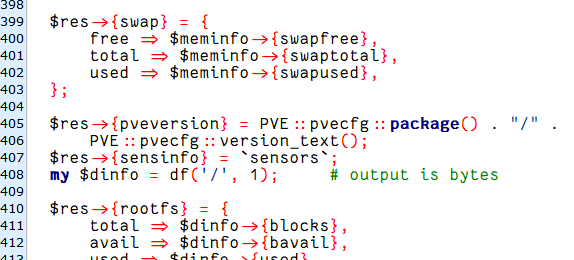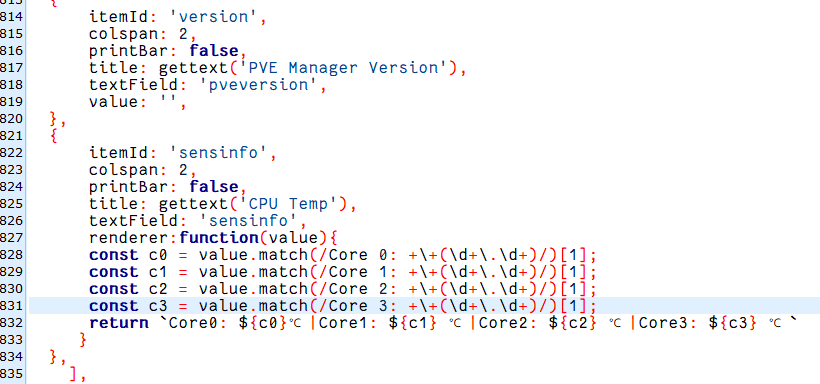If you want to obtain hardware temperature information for the PVE host and display it in the PVE control panel for real-time server monitoring, refer to the image below:

Install Hardware Monitoring Software Sensors
You need to install hardware monitoring software. For detailed installation procedures, please refer to this article: https://bmzhp.com/experience/281
Modify and Add Display Code
Edit the following file: /usr/share/perl5/PVE/API2/Nodes.pm
Open the file using:
1
|
vi /usr/share/perl5/PVE/API2/Nodes.pm
|
Search for the line containing PVE::pvecfg::version_text(); and add the following line below it:
1
|
$res->{sensorsInfo} = `sensors`;
|

Next, edit /usr/share/pve-manager/js/pvemanagerlib.js
Open the file using:
1
|
vi /usr/share/pve-manager/js/pvemanagerlib.js
|
Search for the section labeled PVE Manager Version and insert the following code right before the closing curly brace:
1
2
3
4
5
6
7
8
9
10
11
12
13
14
15
16
17
18
19
20
21
22
|
| | { |
| --- | --- |
| | itemId: 'sensorsInfo', |
| | colspan: 2, |
| | printBar: false, |
| | title: gettext('CPU Temperature'), |
| | textField: 'sensorsInfo', |
| | renderer:function(value) |
| | {const p0 = value.match(/Package id 0: ++(\d+.\d+)/)[1]; |
| | const c0 = value.match(/Core 0: ++(\d+.\d+)/)[1]; |
| | const c1 = value.match(/Core 1: ++(\d+.\d+)/)[1]; |
| | const c2 = value.match(/Core 2: ++(\d+.\d+)/)[1]; |
| | const c3 = value.match(/Core 3: ++(\d+.\d+)/)[1]; |
| | const c4 = value.match(/Core 4: ++(\d+.\d+)/)[1]; |
| | const c5 = value.match(/Core 5: ++(\d+.\d+)/)[1]; |
| | const c6 = value.match(/Core 6: ++(\d+.\d+)/)[1]; |
| | const c7 = value.match(/Core 7: ++(\d+.\d+)/)[1]; |
| | const c8 = value.match(/Core 8: ++(\d+.\d+)/)[1]; |
| | const c9 = value.match(/Core 9: ++(\d+.\d+)/)[1]; |
| | return Package: ${p0} ℃ || Core 1: ${c0} ℃ | Core 2: ${c1} ℃ | Core 3: ${c2} ℃ | Core 4: ${c3} ℃ | Core 5: ${c4} ℃ | Core 6: ${c5} ℃ | Core 7: ${c6} ℃ | Core 8: ${c7} ℃ | Core 9: ${c8} ℃ | Core 10: ${c9} ℃ |
| | } |
| | }, |
|

Restart PVE Web Service
To restart the web service, use the following command:
1
|
systemctl restart pveproxy
|
This will restart the web service and refresh the page.
Now, simply access the control panel and refresh the page to see the changes.



